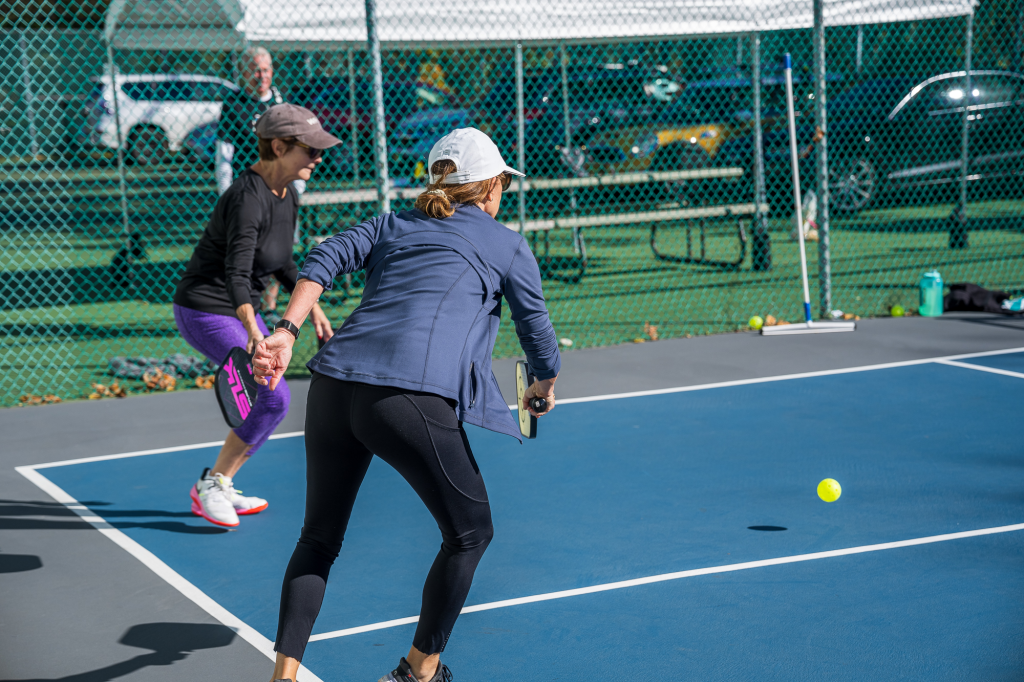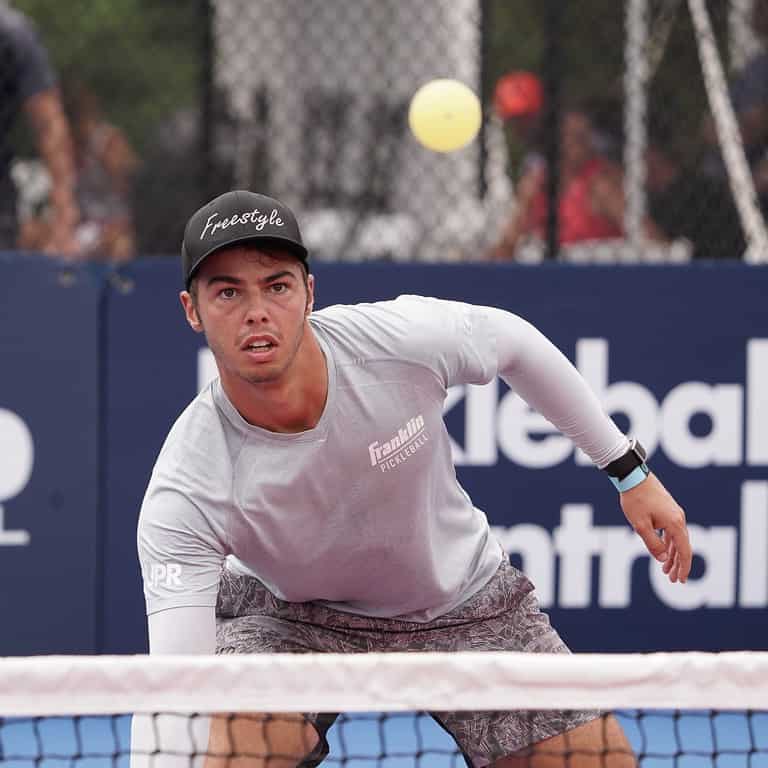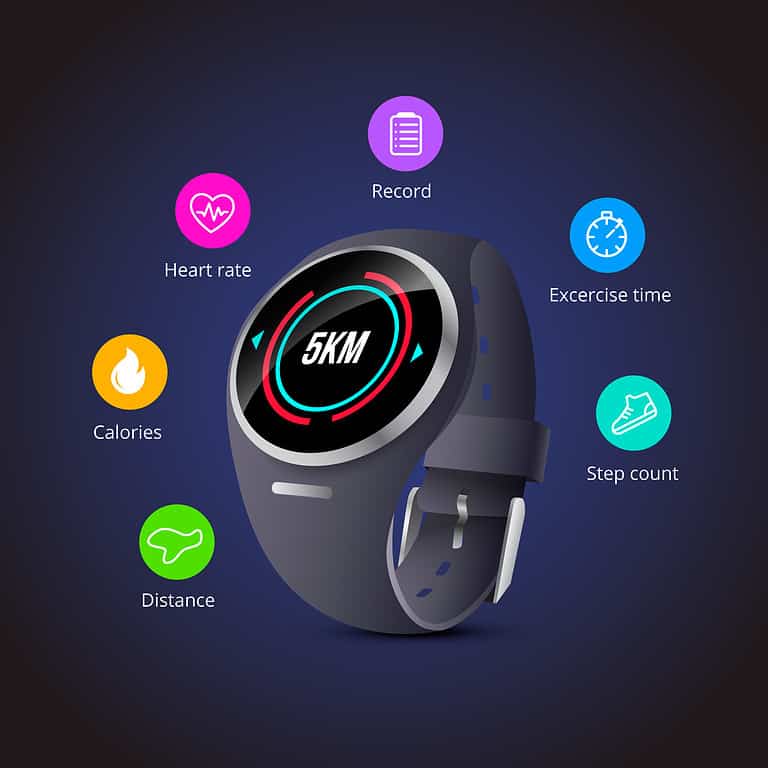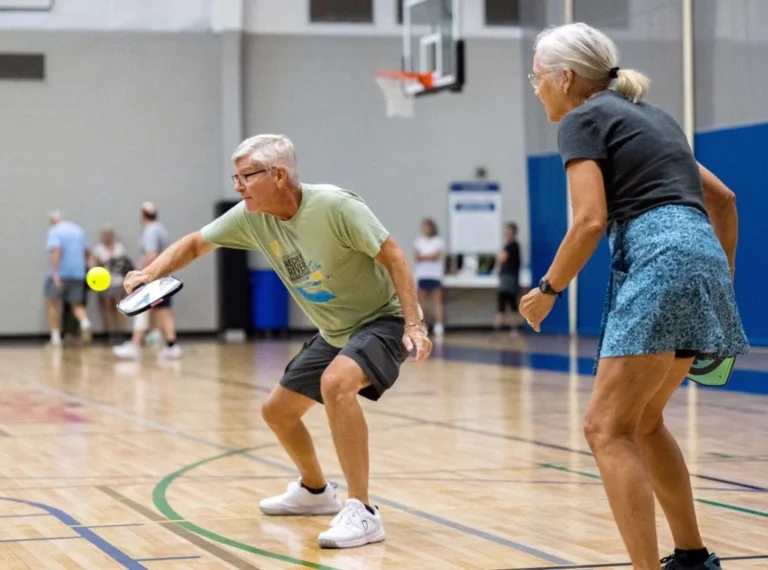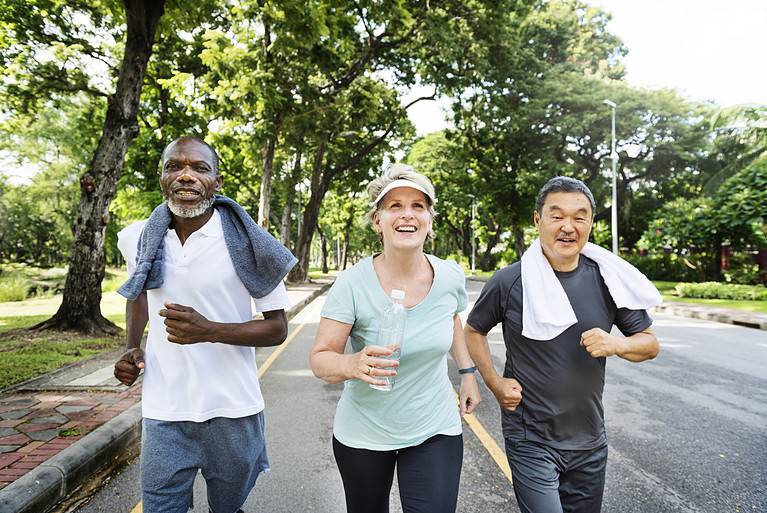16 Best Pickleball Warm-ups, Stretches & Drills- Get Game Ready
I decided to write this blog due to the number of injuries I have seen on the court and even experienced myself. A proper pickleball warm-up is a very simple way to play healthy and safe. There’s nothing silly about warming up pre-game. Professional athletes do this religiously. So should we.
I am an avid pickleball player. I play multiple times a week, and I have come to realize that I do need to make sure to invest in warming up pregame. It has helped me to reduce any stiffness and improve my range of motion prior to gameplay. With more people playing pickleball, injury prevention is becoming critical.
I have seen so many injuries on the court. Everything from running into the net or the fence causing shoulder and wrist injuries to tripping and falling going for lobs or trying to get difficult angled shot returns. I have also personally experienced and seen more and more eye or face injuries from balls coming at the head and body. Many of my friends have had overuse injuries in their shoulders, elbows, and knees (including me). With some even having hairline fractures in their feet.
So injuries on the court are real, and the good news is most can be prevented.
The rise in participation has been remarkable, A recent CNN article indicated that pickleball injuries could cost $400 million in health care costs.
According to a 2019 report in the Journal of Emergency Medicine, there were approximately 19,000 pickleball injuries per year, with a staggering 90% of those injuries affecting people aged 50 or older. This is my demographic.
There has also been a study published in the journal Injury Epidemiology in 2021 revealed that pickleball injuries increased rapidly between 2010 and 2019, with 85% of the injuries sustained by individuals aged 60 and over.
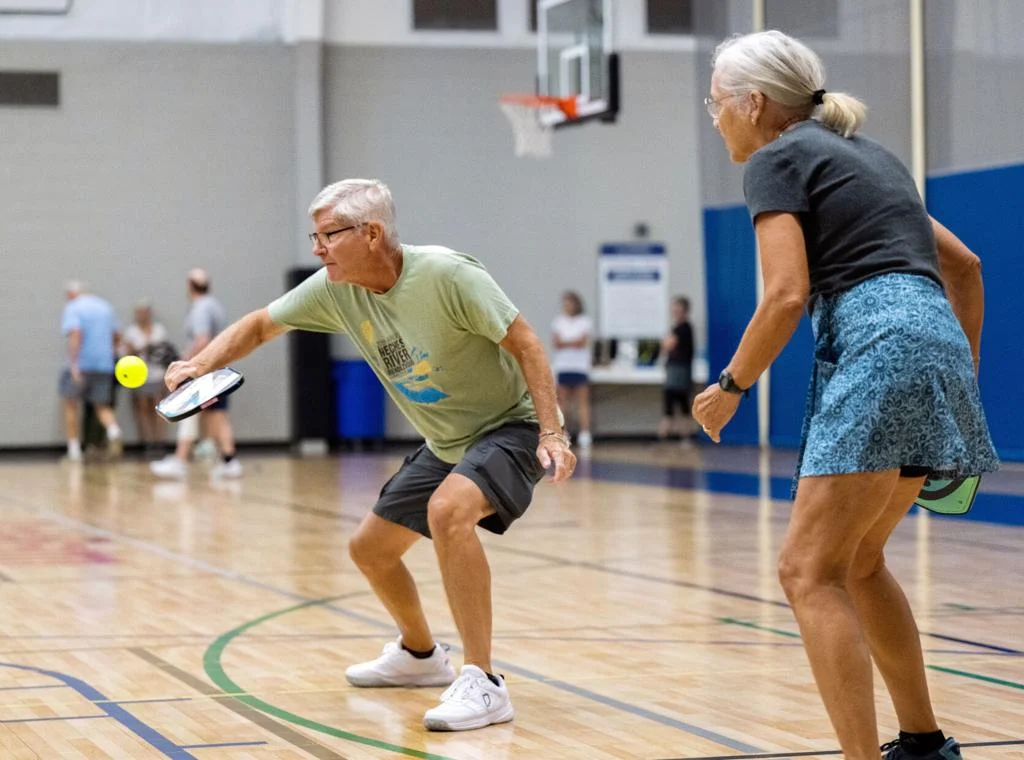
Common Injuries Associated with Pickleball

Among the various injuries associated with pickleball, the most common is lateral epicondylitis, commonly referred to as “pickleball elbow” or “tennis elbow.” This overuse injury affects the tendons of the elbow and is commonly seen in players of racket or paddle sports.
Pickleball players are also prone to other common injuries, including tendinitis, fractures, sprains, tears, and even concussions, often resulting from overuse or repetitive wear and tear.
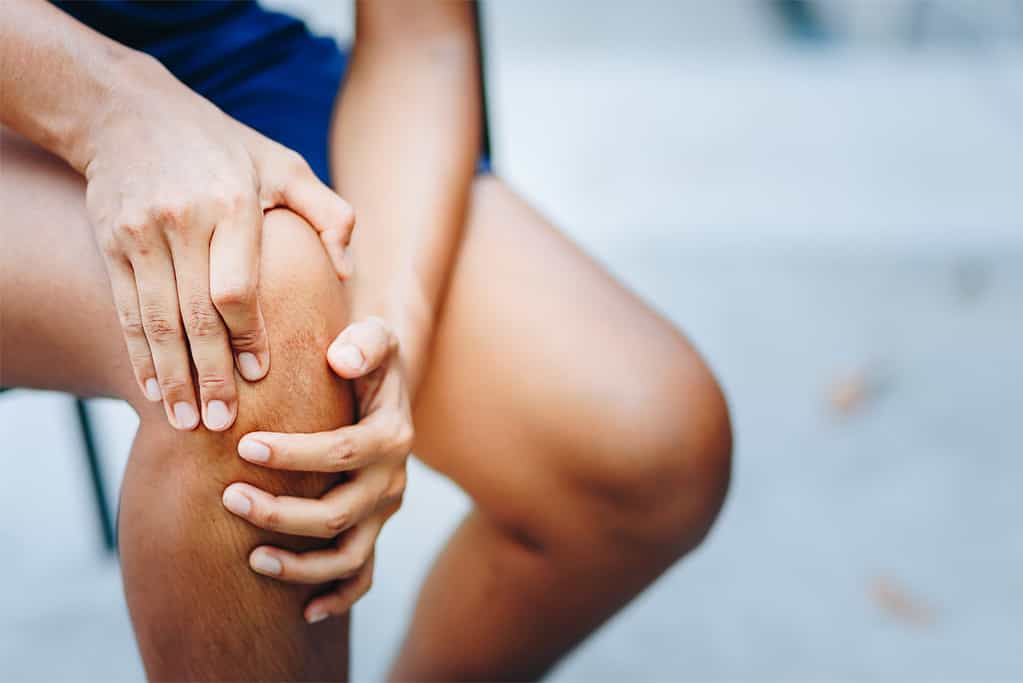
Pickleball’s popularity really grew during the pandemic. This has led to a significant increase in injuries. Analysts estimated around 67,000 emergency room visits, 366,000 outpatient visits, and 9,000 outpatient surgeries related to pickleball injuries in 2023.
Strained muscles, such as the calf, hamstring, and Achilles tendon, are frequently reported injuries, and ankle sprains are also common. I have seen players pull up due to a hamstring injury and not be able to play for weeks. Many of these are associated with not doing proper a pickleball warm-up.
Prevention and Treatment of Pickleball Injuries
Preventing pickleball injuries involves incorporating several strategies. This includes prioritizing a proper pickleball warm-up routine before starting play, and focusing on major muscle groups like calves, quads, hamstrings, inner thighs, back, shoulders, elbows, and wrists.
Additionally, investing in properly fitting pickleball shoes with good grip can help protect knees during play, and clearing any debris on the court before starting a game can also prevent injuries. A pickleball shoe is different than a running shoe. They provide much more lateral stability for your feet.
Don’t forget proper eyewear or safety glasses or goggles.
In cases where injuries do occur, the RICE method (rest, ice, compression, elevation) is often recommended for acute injuries accompanied by inflammation and swelling. However, if pain persists, seeking professional medical care is very important. to
So while pickleball is a fun and social sport, it’s crucial for all of us to be aware of the potential for injuries and take appropriate preventative measures. By understanding the common injuries you can get with pickleball and implementing preventive strategies, you can continue to enjoy the sport safely and reduce the risk of injuries.
Recommended Simple Pickleball Warm-up Routine
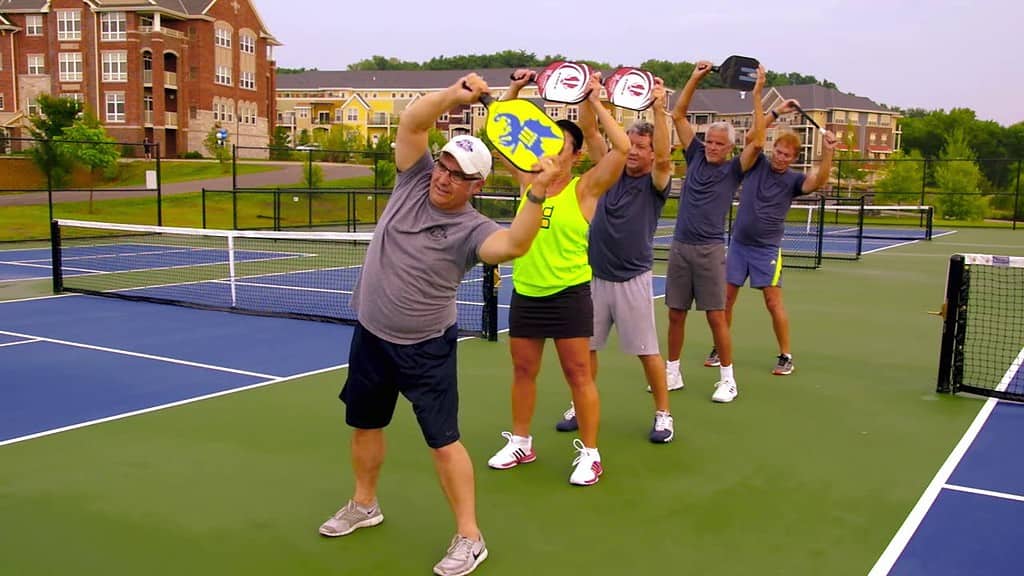
Whether playing pickleball casually or competitively, such as League play, doing a routine of stretching and warm-ups is a critical aspect of the game. This practice prepares both your body and your mind for the physical and mental demands of the game.
What do warm-ups do for your body? Stretching and warming up increases muscle temperature and elasticity, improving your flexibility and efficiency of movements. This improves performance and reduces the risk of common injuries like strains, sprains, and tendonitis.
Warming up the cardiovascular system gradually also helps manage the increased heart rate that comes with active gameplay. Important for those who have heart conditions.
What do warm-ups do for your mind? A good warm-up routine sharpens focus and heightens body awareness. This results in better coordination, quicker reaction times, and improved strategic decision-making – valuable advantages in casual and competitive play. This is why we all see the pros warm-up on the court prior to every match they play
Regardless of the level of play, incorporating stretching and warming up into your pickleball routine ensures you’re primed for the game physically and mentally, maximizing performance, enjoyment, and, most importantly, minimizing the risk of injury.
Stretching Component of On-Court Pickleball Warm-up
These are all court-friendly stretches that don’t require sitting or lying down. These are great to do before a game of pickleball.
- Standing Quad Stretch: While standing, bend one knee, lift your foot towards your glutes, and grasp your ankle. Keep your other hand out for balance. Hold for 15-30 seconds each side.
- Calf Stretch: Stand arm’s length from a wall or fence, place both hands on the surface, and move one foot back, pressing the heel into the ground. Keep your other foot forward. Lean into the wall until you feel a stretch in your calf of the back leg. Hold for 15-30 seconds and repeat on each side.
- Shoulder and Tricep Stretch: Raise one arm overhead, bend at the elbow so your forearm is behind your head, and reach your fingers down towards your upper back. With the other hand, gently pull your elbow towards your head. Hold for 15-30 seconds each side.
- Standing Hamstring Stretch: Stand and prop one heel up on a low barrier like a bench or step, toes pointing up. Keeping your back straight, lean forward from the hips until you feel a stretch in the hamstring of the raised leg. Hold for 15-30 seconds each side.
- Standing Hip Stretch: Use a fence or a wall for support. Cross one ankle over the opposite knee, creating a figure 4 with your legs. Gently bend your standing leg, pushing your hips back to create a stretch in your hip and glutes. Hold for 15-30 seconds on each side.
- Torso Twist: Stand tall with your feet hip-width apart. Keep your hips and lower body stationary and slowly rotate your torso to the left, then to the right, to stretch your core and lower back. Hold each side for 15-30 seconds.
- Wrist Stretches: Extend one arm out in front of you, palm up. Use your other hand to gently pull the fingers back towards your body, stretching the forearm and wrist. Then, flip your hand so the palm is facing down and gently pull back on the hand, stretching the top of the wrist. Hold each stretch for 15-30 seconds on each side.
Remember, it’s important to warm up your body with a little light cardio activity before stretching, and keep your stretches gentle – never to the point of pain. Let’s go through the active components of the light cardio.
Dynamic Component of On-Court Pickleball Warm-up
We’ll go through a series of active pickleball warm-up exercises to get our bodies prepped and our minds focused. Here’s our game plan:
- Jog Around the Court: Start by lightly jogging around the outside of the court for a couple of minutes. This will help get our heart rate up, and our muscles warm up. Don’t rush – this isn’t a race. (if you walk or bike to your court, this counts)
- Jumping Jacks: Next, do 20-30 jumping jacks on the court. This full-body movement prepares our arms and legs for the various movements we’ll be performing during the game.
- Arm Circles: Now, warm up your shoulders with arm circles. Stand with your feet shoulder-width apart. Extend your arms to the sides and make small circles, gradually increasing to larger circles. Do 15-20 in each direction – forward and backward.
- Leg Swings: Find a partner or use your paddle for balance, and let’s do some leg swings. Perform 15-20 swings with each leg, front to back and side to side. This helps warm up your hips and legs, which is essential for those quick side-to-side movements.
- Squats: Let’s follow up with 10-15 bodyweight squats. This will warm up your glutes, quads, and hamstrings, which will be critical for those quick, powerful movements on the court.
- Lunges: Next, perform walking lunges across the width of the court. Make sure you’re stepping far enough forward to keep your knee directly above your ankle. This is an excellent exercise for warming up your legs and improving balance.
- Mini Volleys: Grab your paddles and a partner, and let’s work on some mini volleys right at the net. This will help us warm up our coordination and reaction skills.
- Dink Practice: Next, let’s spend a few minutes practicing our dinks. Remember, these soft shots are all about control, not power. Let’s get that touch and finesse warmed up.
- Serve and Return Practice: Lastly, we’ll spend a few minutes on serving and returning serves. This will help us warm up our accuracy and timing.
Remember, the purpose of a pickleball warm-up is to increase your heart rate, get your blood flowing, and loosen up your muscles. We’re not trying to wear ourselves out before the game even starts. Take your time with these exercises – the aim is quality, not speed.
All of these can be done on the court before your game. It should take about 5-7 minutes or so to get through the exercises 1-6. The remaining practice-oriented pickleball warm-up can be done for as long as you feel necessary.
Closing
Remember that the ultimate goal is to play and enjoy the sport we love, while safeguarding our health and well-being. In both casual and competitive play, pickleball offers many benefits – from physical fitness to social interaction and mental stimulation. However, its recent surge in popularity has highlighted the importance of injury prevention.
The rate of pickleball injuries, as the data show, is alarmingly high, especially among the older population (that’s me). Recognizing this, I’ve detailed some simple preventative measures and focused on pre-game warm-ups.
Doing these regularly can reduce the risk of the most common injuries associated with the sport, from pickleball elbow to knee and ankle injuries.
We have shown the importance of a tailored warm-up routine in pickleball. The goal is not to just avoid injuries but also to improve performance on the court. With exercises focusing on major muscle groups and specific pickleball movements, we hope to assist you in preparing for each game physically and mentally. Remember, a thorough warm-up is not a luxury, but a necessity, regardless of your level of play.
Beyond physical preparation, we have also highlighted other crucial strategies like proper hydration, wearing appropriate footwear, and maintaining a safe playing environment. These simple measures can significantly reduce injury risks and help you get the most out of the game.
So, let’s remember to always take the time to prepare our bodies for the fun, challenge, and excitement that pickleball brings. The few minutes spent warming up and stretching can be the difference between an enjoyable game and a painful injury. With the right mindset, preparation, and respect for our body’s needs, we can continue to enjoy this rapidly growing sport for many years to come.
On and off the court, let’s commit to prioritizing our health and safety. After all, an injury-free player is a happy player. Let’s play smart, play safe, and keep enjoying the fantastic game of pickleball!
Frequently Asked Questions
Should you warm up before playing pickleball?
Absolutely yes. There are several simple warmups that you can do on court that take just a few minutes. Also, practicing your dinking, serves, and drives before starting your game is a great way to warm up.
What stretches should I do before playing pickleball?
Some excellent stretches include quad stretch, torso stretch, side-to-side lunges, wrist stretch, arm circles, and leg swings.
What is the most common injury in pickleball?
Ankle injuries such as strains and sprains, overuse injuries, and falls due to poor footwork.
Do you need hydration powders when you play pickleball?
Yes. Hydration powders are an absolute must in hot, humid climates. However, many players forget to get basic electrolytes during normal, strenuous play. Learn more about the Best Hydration Powders for Pickleball.
What are the best paddles to prevent injuries?
Weight is a key factor when looking for a pickleball paddle that will reduce your chance of injury. There are some excellent lightweight paddles that are pro-competitive. 6 Best Pickleball Paddles for Women and 5 Best Pickleball Paddles for Seniors. Both these contain exceptional lightweight paddle options.
What pickleball paddle does Anna Leigh Waters use?
Anna Leigh Waters uses a Paddletek Bantam TS-5 Pro* pickleball paddle.
*Available on Amazon

